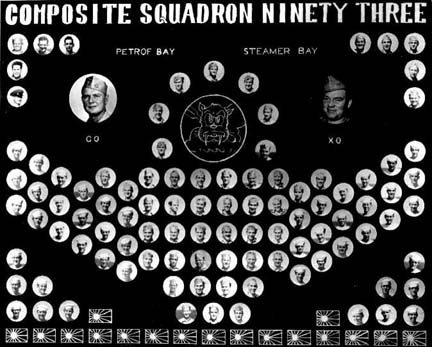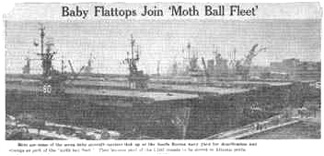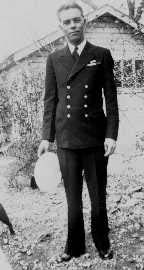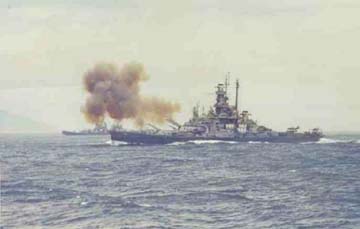|
Regardless of what direction the Japanese originated their attack
one of the Navy sections would see the Japanese planes and would
initiate a turn into the Japanese planes. The other Navy section
would see the first Navy section and know they were being attacked.
At this time they would turn in to meet the first section passing
either over or under as indicated by the first section. The first
section would bring their guns to bear on the Japanese planes
in a head on run forcing the Japanese to break off their attack
on section two. After passing the Japanese, the first section
would either return to it's original course or complete a one
hundred and eighty degree turn. Section two would be alert to
section one's actions and would follow suit, thus returning to
their original positions abreast of each other ready to meet
the next Japanese attack if necessary.

VC 93 Composite Photo 1945 |
The "Thatch Weave" was very successful and undoubtedly
saved many American lives. Not only was Commander Thatch highly
respected for his contribution to the war effort, he was, also,
an ace Navy pilot having shot down more than a few Japanese planes.
In trying to imagine how these early pilots might have felt flying
into almost certain suicide, and how I might have reacted to
the same situation, I consider the fact that although the enemy
air opposition was greatly reduced, we were still flying into
heavy antiaircraft fire. Never once did I consider ducking out
because of fright. So I suspect that had I been one of these
early pilots I, too, would have flown into a nest of Japanese
planes with complete confidence that I would survive just as
I'm sure they did. Death is something that happens to someone
else.
One of the other pilots of the squadron had a quote that expresses
my feeling for my experiences as well as he felt for his. It
goes like this "When I tell people that I was a carrier
pilot, regardless of whether they are pilots of one of the other
less fortunate services, or a civilian pilot or an ordinary citizen,
they always say that they are amazed that anyone could or would
land on one of those "boats". Quite frankly so was
I. As a matter of fact, every time I caught a wire I would say
to myself: Hot Damn, you did it again!"
Many years later at the 45th reunion of my high school graduation
I returned to Abraham Lincoln High to find that the school had
honored all of its students who had served in the military during
WW II by inscribing their names on the wall above the office
doors. I could find everyone's name that I knew, including my
brother Melv's, even though he had gone to East High his last
year. The only name I did not find was mine. I guess after forty
five years no one there could give a s--- about any of those
who served much less whether someone's name was missing. Still,
my feelings were hurt.

CVE 80, USS Petrof Bay in the foreground in this newspaper article
from the Los Angeles Times in the early '50s. |
I suppose that over the years I might have been "pissed-off"
many times and for many reasons. Other than the over sight by
my high school, I think the thing that "pissed" me
most was the fact that I flew 54 official missions in enemy occupied
territory in direct support of our troops against the enemy and
on |
target combat air patrol in areas occupied by enemy aircraft.
Even though we were not fortunate enough to make contact with
the enemy these TCAP's were qualifying flights for the Air Medal
and the DFC.
By coincidence, George Bush, the future president, and I flew
nearly the same number of missions. He flew 56 missions and lost
only one plane of record and two aircrewmen. I lost two planes
but no aircrewmen. He got his DFC and several air medals and
a lot of back-patting for his war time service while he was president.
Seems the Navy could at least match his medals.
I had, in fact, been recommended for the DFC and four Air Medals.
The recommendation had been approved by A.E. Montgomery, Admiral,
U. S. Navy. I received the Air Medal and one star in lieu of
the second before being discharged. The other two Air Medals
and the DFC never came.

Chief Melvin W. Allison |
At our first squadron reunion in 1984, the skipper confirmed
that the medals I had not received and those in the squadron
who also had not gotten theirs had been officially approved and
we were eligible to receive them. Maybe one day I'll make an
inquiry.
The squadron reunion held in 1984 was very successful. Every
two years since we have repeated the reunion even though our
ranks are being thinned severely.
As for my brother, Melv, after the Pearl Harbor attack he returned
to Norfolk, Va. where he was assigned to the newly commissioned
USS Indiana, BB 58. |
|
He was to remain on the Indiana to the end of the war.
Never could get him to talk about his experiences for his years
in the Navy.
Carl, on the other hand, would tell of his experiences at
the drop of a pin. After pre-pre-flight he was assigned to pre-flight
in California and then to primary at Livermore, Ca. |

USS Indiana, BB 58 |
At this station he and the Navy parted company due to a disagreement
between him and his instructor- that is a story in it's self.
After leaving the Navy he went to work as a longshoreman in San
Francisco. This lasted until he was accepted into the Army Air
Corps cadet program. |